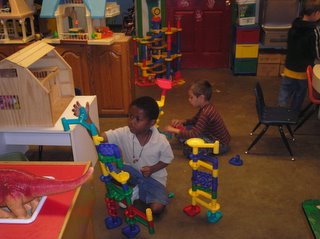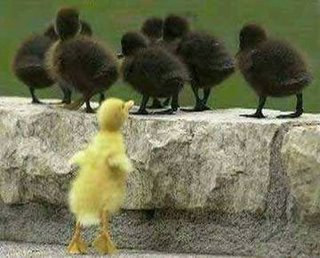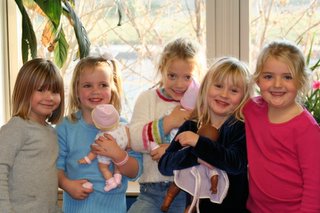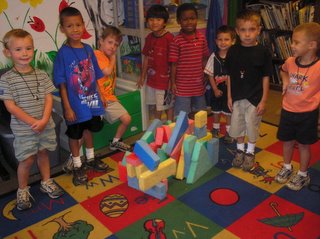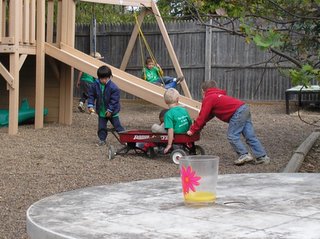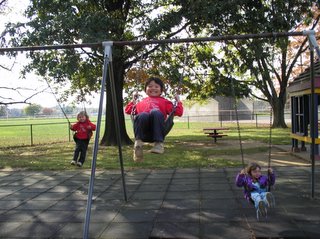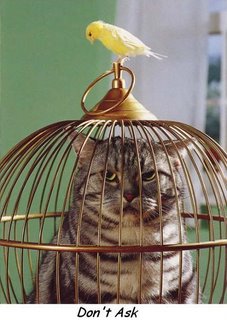 This is a really fine article - long, I admit, but well worth reading. It reminds me of all the things the GS has been trying to do for a long time. We are in many ways a charter school with a different approach to teaching and learning.
This is a really fine article - long, I admit, but well worth reading. It reminds me of all the things the GS has been trying to do for a long time. We are in many ways a charter school with a different approach to teaching and learning. JSonline
Changes at street level
North Ave. offers array of education options
By ALAN J. BORSUK
aborsuk@journalsentinel.comPosted: Dec. 10, 2005
First of three parts
When Ronn Johnson started teaching at Lee Elementary School just off W. North Ave. in 1989, there was one dominant option for schooling in the neighborhood: Lee Elementary, an aging Milwaukee Public Schools building with low test scores and a conventional program.
North Avenue: Main Street Of School Reform
Sixteen years later, Johnson is still an educator in the neighborhood. But now he works five blocks away in a school that was unthinkable in those days.
The Young Leaders Academy is a charter school - charters weren't created until the early 1990s. It shares a building with a YMCA branch - the first pairing like that in the United States didn't happen until 2000, a few blocks farther down North Ave.
It has a highly charged curriculum with some of the coloration of a military school - there was nothing like that on the Milwaukee map in those days. Now, there are two on North Ave. alone.
It operates outside the MPS system, is open to any city child who applies and makes it through the waiting list, and is funded with public money. Unheard of in 1989.
Immediately behind Young Leaders Academy is Sharon Junior Academy, a Seventh-day Adventist school funded largely with public money through the nation's first and most encompassing school voucher program. Another voucher school, this one non-religious, called the Milwaukee School of Choice, is kitty-corner.
These schools are part of an array of publicly-funded schools that have developed rapidly along a stretch of less than four miles from N. 9th St. to N. 52nd St. Put them together, and this is an appropriate slogan for North Ave.: the main street of American school reform.
Along the avenue, you'll find MPS schools with markedly different approaches. Charter schools. Voucher schools. Schools offering language immersion. Schools offering religious education.
Schools with an emphasis on early childhood education. Highly structured "no excuses" education. In-your-face, military-boot-camp education. An emphasis on business, starting from the early grades at a school run by a for-profit company.
North Ave. is a microcosm of the wealth of things being done to help educate low-income black students and is ground zero in Milwaukee (which itself has been called ground zero in America) for school reforms of many kinds - all of them paid for with public money.
"This whole plethora of schools has inspired this community and given this community hope," Johnson says. "All of the schools along the avenue are sending a very strong message to the community that education is the key, and there are very strong options."
But if North Ave. illustrates how parents in Milwaukee have a wider array of choices in publicly funded education than parents elsewhere in America, it does not yet provide convincing answers of what will come from the innovations.
Is North Ave. the route to closing the achievement gap between the haves and have-nots that is perhaps the most urgent issue in American education? What will be going on along this street 10 years from now, and will the overall picture for children now enrolled in these schools be one of success?
Factors for change
Why has North Ave. become such a vivid example of the changing education scene?
Consider three reasons:
• The need was great. Fifteen years ago, in the neighborhoods along this length of the street, relatively few students did well. It is clear from the response to the school boom that many parents wanted fresh options for their children. And educational, political and civic leaders, as much as they disagree on many things, all agree that raising the level of success in this area is a top priority for the city. It was not a coincidence that MPS and the Boys & Girls Club put their combined new facility on the street, that the Milwaukee Urban League looked to the area to locate its charter school, and that the YMCA built its new facility, including a school, on the street.
• There was a major shortage of school seats along North Ave., a fact shown in the research done when MPS created its Neighborhood School Initiative in 2000. Hundreds of students every day were bused out of the area to schools across the city simply because the schools in the area, such as Clarke Street School, had too little room.
Several schools in nearby areas have new additions, as a result of the more than $100 million spent on the neighborhood plan, and there's one entirely new MPS building not far away, the new Mary McLeod Bethune Academy at 1535 N. 35th St., which replaced the run-down 37th Street School this year.
• Location and access. When enrollment was faltering at the MPS French Immersion School, then located on the southwest side, policy-makers looked for a more central location and selected the building of the poor-performing Steuben Middle School at North Ave. and N. 52nd St., which was being closed. North Ave. is generally easy to get to and relatively central to the whole reach of areas where low-income students live.
The net effect is that North Ave., instead of exporting children all over the city for schooling, might well be a net importer of children now, although no one has compiled such numbers. There are far fewer students leaving the adjacent neighborhoods for elsewhere than there were a few years ago, and many students come from across the north side and sometimes from the south side to attend schools along the street.
There also have been tens of millions of dollars invested just in the physical facilities of schools along North Ave., which some point to as a part of a general improvement in vitality of the area.
At every one of the North Ave. schools, whether MPS, charter or voucher, the budget is driven almost entirely by how many students attend. Finding a market niche, convincing parents that you can serve their children best, treating parents like "customers" - that's the thinking.
"The competition (to get kids) is just out of this world," said Shannon Kilsdonk, in her first year as principal of Hi-Mount Community School. "Everyone wants the students."
There are some winners in the parent-driven market along North Ave. MPS' Starms schools have grown to almost 800 students in three buildings; the Milwaukee Urban League Academy of Business and Economics has outgrown its building at N. 38th St. and North and is using a second building at N. 46th and W. State streets; Milwaukee College Preparatory School and Young Leaders Academy have waiting lists.
Some schools are struggling, too. At Lee, enrollment was almost 700 in 1990; this year, it is 359, and that's with grades six to eight added to the school, one of many in MPS that has become a kindergarten-through-eighth grade school in recent years.
Johnell Sharp, who is retiring this month after 15 years as principal, reflected on how the school has changed in a recent interview: more mobility among the students who remain; a higher percentage of students with special education needs; more behavior problems, especially with the introduction of middle-school students; too many parents who take too little responsibility for their children; many parents who want high standards of conduct and academics moving their children to charter and voucher schools.
"Today's children are different," he says with a sigh.
Extra challenges
Many MPS teachers feel put upon in the new reality. They argue that their schools end up with a disproportionate share of children who have special education needs and behavior problems, while voucher schools, particularly, do not have to meet the accountability demands put on public schools.
"We're like a Statue of Liberty, give us your weak, your strong, we will educate them," said Selestine Skipper, principal of Metcalfe School.
Along North Ave., there is evidence to support such concerns. Most of the charter and voucher schools have special education students, some more than others, but the MPS schools appear to have larger shares and the children with more severe problems. (The charter and voucher schools do not receive any additional funding to work with special ed students the way MPS schools do.)
And while no school has a monopoly on either good or bad behavior, the charter and voucher schools make more active use of the option of sending students who don't meet the program's standards off to other schools. Critics say the schools are, in effect, selecting the best students; supporters say the schools are showing they mean business about high standards.
At Hope Christian School, a rigorous "no excuses" program at N. 25th St. and North Ave., Kole Knueppel, superintendent of this and two other rapidly growing Hope schools, says, "The kids will respond to whatever your expectation is." In his view, on North Ave., you are seeing "the magic of school choice."
Hope Christian Principal Scott Raymond taught at a nearby MPS school for several years before joining this school. The differences at Hope, he says, lie in such things as more structure, the "no excuses" commitment to children succeeding, more attention to detail in how to get students to succeed, and the religious and moral content of the program.
MPS Superintendent William Andrekopoulos says the growth of strong options on North Ave. shows how committed educators in MPS and outside the system are to finding ways to innovate in pursuit of educational success for children.
"Innovation is in the DNA of this community," he says, adding that nowhere else does a city have the diversity of choices that are offered in Milwaukee.
Andrekopoulos says that even as MPS enrollment has declined in recent years, the public school system remains the dominant choice in the city and, in reality, a higher percentage of students attend public schools in Milwaukee than in many other large cities, even with the rise of voucher and charter schools.
It is hard to look at North Ave. and not conclude that competition has changed the reality and added incentive to what every school is aiming to do.
Andrekopoulos says: "We do things differently because we have to compete. We have a consciousness of all the options in the community."
At the Young Leaders Academy, Ronn Johnson says, "It's very clear to the school operators that you have to offer a high quality option or your customers will leave."
He calls the burst of new schools "a wake-up call to everyone that the power has shifted. It's no longer in the district. . . . Parents really have the power now."
